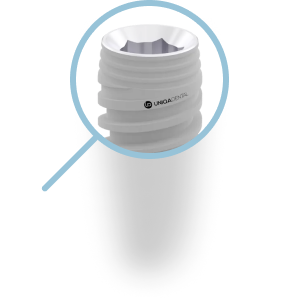Drilling procedure for UNIQA Dental Pure & Porous Implant UH8 UV11 [ 5.0 mm | D4 bone density ]
Video description of the drilling protocol
IMPORTANT: Before inserting UNIQA Dental implants, you should familiarize yourself with the protocol for properly preparing the site in readiness for implant placement.
To install Uniqa Dental implants, it is necessary to follow a protocol that should be carried out by an experienced dentist. Prior to installation, it is important to review the protocol for installing a 5.0 mm implant into soft bone of type D4. First, a hole must be drilled into the hardest cortical layer of the bone using a special drill for cortical bone. The thickness of the cortical layer in D4 bone is small, approximately 1.0-2.0 mm. Then, using a pilot drill with a diameter of 2 mm, drill the hole to full depth, which is usually about 10 mm, but implants of 16 mm or more in length also exist. When drilling, provide moderate force and intense irrigation to cool the drill and bone.
Next, use drills in order of increasing diameter to expand the hole to the required depth. First, expand the hole to 2/3 depth using a 2.5 mm diameter drill. Then, expand the hole to 2/3 depth using a 2.8 mm diameter drill, followed by using a 3.2 mm diameter drill to pass through 1/2 of the full depth of the hole. Finally, expand the hole to 1/2 using a 3.65 mm diameter drill. This is sufficient since the bone is soft and the implant body will enter due to its own thread and provide close to the necessary primary stability.
During drilling, it is important to provide intense irrigation with water to avoid overheating of the bone and thermal necrosis of the bone tissue after implant installation. After each drill passes through, it is necessary to thoroughly rinse the hole with isotonic or physiological sodium solution to remove bone tissue residues and reduce the temperature in the bone.




![Drilling procedure for UNIQA Dental Pure & Porous Implant UH8 UV11 [ 4.2 mm | D4 bone density ]](https://img.youtube.com/vi/ncnwOoxrAO0/maxresdefault.jpg)


